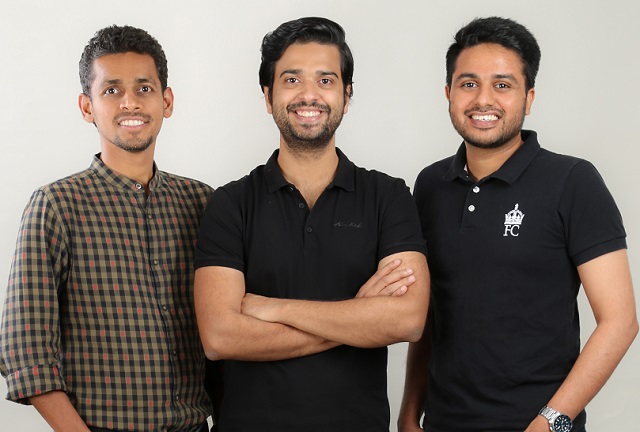
CXOToday has engaged in an exclusive interview with Kazam Founders – Paras Shah CFO (left), Vaibhav Tyagi Co-founder & CTO (center), Akshay Shekhar Co-founder & CEO (right)
What is Kazam’s mission and how does it aim to address technological challenges in the automotive industry?
Ans. Kazam specializes in developing device-agnostic e-mobility software platforms for EV charging and swapping operators. With their software, operators can efficiently control, manage, and analyze fueling assets for optimized e-mobility operations.
Kazam stands out as a highly adaptable and integrative solution, aligning closely with top Original Equipment Manufacturers (OEMs). This means that their software platform can seamlessly integrate with various EV models and charging infrastructure, regardless of the manufacturer. By providing a unified layer for data interoperability and agnosticism, Kazam enables smooth data exchanges among stakeholders involved in the entire vehicle value chain, including utility grids, charging station operators, and vehicle manufacturers. This collaborative approach fosters harmonious cooperation and empowers all parties to work efficiently towards shared goals.
Additionally, Kazam’s collaboration with multiple tier-1 EV OEMs further strengthens their offering, as it allows operators to generate revenue demand. By aligning their platform with renowned EV manufacturers, Kazam enables operators to leverage the popularity and customer base of these OEMs to attract more users and increase revenue streams.
How does Kazam’s agnostic systems approach align with the increasing demand for autonomous vehicles, electric vehicles, and connectivity in the automotive sector?
Ans. Kazam’s agnostic systems approach aligns well with the increasing demand for autonomous vehicles, electric vehicles (EVs), and connectivity in the automotive sector. Here’s how:
- Autonomous Vehicles: Kazam, while not currently working with autonomous vehicles, has laid the groundwork for future collaborations in this domain. Through this, Kazam’s software will be able to track the route of these vehicles, ensuring efficient access to charging and swapping services and seamless integration into the broader transportation ecosystem once the partnership with autonomous vehicles becomes a reality.
- Electric Vehicles: As the adoption of electric vehicles continues to grow, there is a need for robust charging infrastructure and efficient management of charging assets. Kazam’s device-agnostic software platform addresses this by allowing EV charging and swapping operators to control, manage, and analyze their fueling assets effectively, regardless of the EV manufacturer. Kazam’s remarkable flexibility empowers operators to accommodate a diverse array of EV models and charging infrastructure. This user-friendly approach makes it a breeze for consumers to locate and access charging services, irrespective of the electric vehicle brand they own.
- Connectivity: Kazam’s agnostic systems are at the forefront of driving innovation in the automotive sector by facilitating four major connectivity aspects. Firstly, they enable vehicle connectivity to the internet for efficient fleet management with real-time tracking and diagnostics. Secondly, they ensure seamless communication between EV chargers and electric vehicles, providing convenient charging options. Thirdly, these systems promote smart grid management, allowing vehicles to adapt charging schedules based on grid conditions for sustainable energy consumption. Lastly, the integration with internal ERP tools streamlines data flow and enhances operational efficiency. Together, these advancements lead to a greener, smarter, and more connected e-mobility ecosystem.
By offering an agnostic approach, Kazam’s systems ensure compatibility and interoperability across different vehicle types, charging infrastructure, and stakeholders. This aligns with the growing demand for flexibility, connectivity, and seamless integration within the automotive sector, ultimately supporting the widespread adoption and efficient management of autonomous and electric vehicles.
In what ways does data interoperability and agnosticism provided by Kazam foster collaboration and coordination among various stakeholders within the vehicle value chain?
Ans.Kazam’s data interoperability and agnosticism play a pivotal role in fostering collaboration and coordination among various stakeholders within the vehicle value chain. In the EV ecosystem, there are four valuable stakeholders that play pivotal roles:
- Vehicle OEMs: Kazam’s data interoperability allows vehicle manufacturers to access real-time information about their vehicles’ locations and the availability of charging stations. This enables them to provide valuable location-based services to their vehicle owners, ensuring easy access to charging infrastructure and enhancing the overall ownership experience.
- Charge Point Operators: With Kazam’s agnostic systems, charge point operators gain access to data from vehicle OEMs, driving utilization by strategically locating charging stations where demand is high. Additionally, connectivity with the utility grid enables them to procure electricity at the lowest price points, optimizing their operational costs and enhancing service efficiency.
- Fleets: Large-scale fleet operators benefit from Kazam’s data interoperability, as they can monitor their vehicles’ charging status in real-time. By leveraging connectivity with the utility grid, fleets can reduce input costs and optimize their operations, resulting in improved efficiency and cost-effectiveness.
- Policymakers: Policymakers can access the data made available through Kazam’s agnostic systems to create data intelligence-based solutions. This empowers them to make informed decisions and design policies that support sustainable and efficient e-mobility practices, contributing to a greener transportation ecosystem.
By providing seamless data exchange and connectivity across these key stakeholders, Kazam fosters a more collaborative and well-coordinated vehicle value chain. This ensures that all entities work together efficiently, driving the growth and adoption of electric vehicles while promoting sustainable mobility solutions.
As software plays a critical role in modern vehicles, what obstacles do you foresee when it comes to integrating software-led systems, and what strategies does Kazam employ to overcome these challenges?
Ans. Integrating software-led systems into modern vehicles poses several obstacles, and Kazam recognizes the need to address these challenges to ensure seamless functionality. There are two primary integration aspects that require attention:
- Charger-to-Vehicle Integration: One of the major obstacles lies in standardizing the communication protocol between chargers and vehicles. In India, where two-wheelers and three-wheelers are being developed for the global market, the lack of a consistent standard across all vehicles makes it challenging to use chargers universally. Kazam is actively working towards establishing a standardized protocol to enable compatibility and interoperability among chargers and vehicles, ensuring a smoother charging experience for users.
- Connectivity and Internet Integration: While connectivity to the internet for chargers is relatively standardized, India lacks strict guidelines on the required standards. Kazam engages with policymakers to advocate for the adoption of consistent connectivity standards. By presenting data on the usage patterns and benefits of specific standards, Kazam aims to influence policy decisions that lead to better integration and connectivity in the charging infrastructure.
Furthermore, the integration of various software tools, such as ERP systems like Freshworks and SAP, presents additional challenges. Kazam continually works on integrating these tools into its system to enable seamless data exchange and efficient management of information.
Moreover, the integration of multiple grid systems onto Kazam’s platform is essential to providing comprehensive information from the utility segment. However, the lack of standardization in the current market complicates this process. Kazam is actively working on incorporating different grid systems to offer users valuable insights and optimize their charging operations.
Despite these obstacles, Kazam remains committed to addressing standardization issues and gradually overcoming integration challenges. It acknowledges that complete resolution may take time but is determined to lead the way towards a more connected and efficient e-mobility ecosystem.
Could you elaborate on Kazam’s approach to user experience in the development of their Charging Management System (CMS)? How does Kazam collect user feedback and incorporate it into platform improvements?
Ans. Kazam takes a user-centric approach in the development of their Charging Management System (CMS), recognizing that different players within the e-mobility ecosystem have unique needs and priorities. To enhance the user experience, Kazam tailors the platform’s features and interface based on the specific requirements of various stakeholders.
For fleet operators who prioritize vehicle management, Kazam ensures that the system revolves around comprehensive vehicle-related information. This includes real-time tracking, diagnostics, and performance analytics, allowing fleet operators to optimize vehicle usage and monitor their health effectively. For charge point operators, the focus is on charging station management and utilization. Kazam prioritizes showcasing vital charging station data and performance metrics to enable efficient charging station management and utilization tracking. For utility grid operators, the emphasis lies on understanding the overall load in the city. Kazam’s system provides a clear view of the grid’s load, enabling grid operators to make informed decisions regarding energy distribution and load management.
To achieve this user-centric approach, Kazam has invested in designing a dynamic dashboard that can present different data points according to the user’s role and preferences. This means that each stakeholder group sees the most relevant and valuable information right from the beginning, streamlining their workflows and decision-making processes. Kazam goes the extra mile by integrating engaging customization and flexibility features into their Charging Management System (CMS). Users can easily add new matrices, create custom reports, and include custom columns, ensuring that they can access and analyze the data that matters most to them. This level of customization empowers users to adapt the platform to their specific needs and use cases, making the overall experience more intuitive and efficient.
To further refine their CMS and continuously improve the platform, Kazam actively collects user feedback. Feedback from various stakeholders is invaluable in understanding their pain points, requirements, and desired enhancements. Kazam incorporates this feedback into their development roadmap, prioritizing features and improvements that will have the most significant positive impact on the user experience. This iterative feedback loop allows Kazam to stay responsive to the evolving needs of their users, ensuring that the CMS remains a powerful and user-friendly tool within the rapidly evolving e-mobility landscape.
How does Kazam’s fleet management solution, including the emobility software suite, optimize charging operations and enhance overall efficiency for fleets?
Ans. Kazam’s fleet management solution, including their e-mobility software suite, significantly enhances efficiency and optimizes charging operations for fleets. By strategically optimizing the placement and capacity of charging infrastructure based on fleet size and vehicle usage patterns, Kazam ensures efficient utilization of charging resources, reducing downtime and operational disruptions. The solution employs dynamic charging scheduling, taking into account factors such as vehicle availability, battery levels, and charging station capacities to minimize idle time and maximize fleet productivity.
Kazam’s fleet management solution, integrated with its e-mobility software suite, optimizes charging operations and enhances overall efficiency for fleets by establishing a seamless connection between vehicles and charging stations. Accurately determining the state of charge of each vehicle, the software strategically plans charging sessions based on real-time data, minimizing downtime and maximizing operational productivity. By proactively planning routes with charging station availability in mind, fleets can enjoy smooth operations, minimize range anxiety, and enhance their e-mobility experience in a cost-effective manner.
Moreover, the software suite incorporates load management techniques, optimizing energy usage and avoiding excessive peak loads to reduce strain on the electrical grid and lower energy costs. With comprehensive data analytics and reporting capabilities, fleet operators gain valuable insights into fleet performance, charging patterns, and costs, enabling informed decision-making and continuous optimization. Integration with vehicle telemetry systems allows real-time monitoring and remote diagnostics, further enhancing operational efficiency. Overall, Kazam’s fleet management solution empowers fleet operators to streamline charging operations, minimize costs, and maximize the efficiency of their electric vehicle fleets.
What is your vision for the future of data exchange and collaboration in the automotive industry, and how does Kazam contribute to shaping that future?
Ans. Kazam’s vision for the future of data exchange and collaboration in the automotive industry is to establish a comprehensive, digitized platform that serves as a single point of access for various stakeholders in e-mobility. Through their software solutions and integrations, Kazam aims to optimize operations across the EV value chain, offering real-time information to vehicle OEMs, grid operators, and other stakeholders. By fostering a collaborative environment, Kazam envisions enabling the development of complex applications that utilize their data source to enhance autonomous vehicles, carbon trading platforms, insurance underwriting, and other innovative solutions, ultimately driving the advancement of the e-mobility ecosystem.








